 |
Focus features two in-depth reviews each month of fine art, architecture and design exhibitions and events at art museums, galleries and alternative spaces around Japan. The contributors are non-Japanese art critics living in Japan. |
|
|
 |
 |
 |
Bridging Earth and Heaven: The Photography and Writings of Edward Levinson
Susan Rogers Chikuba |
 |
A smart yet friendly showcase for fine art on Matsuya-dori just behind the Kabukiza Theatre, Art Gallery M84 opened in 2013. Holding as many as 30 exhibitions a year, it's the post-retirement brainchild of Masanori Hashimoto, a former head of product design at Ricoh. Left photo by Susan Rogers Chikuba; right photo by Edward Levinson |
While I have never seen Ed Levinson without a camera, the accomplished photographer, author, and 35-year resident of Japan does tell good stories about the many times he has had to dash, at the mercy of the muse, to grab one. A choice selection of his serendipitous encounters with nature and other confluences of light is now on display through May 23 at Art Gallery M84 in Ginza, Tokyo.
A new work debuting at the Ginza show, Morning Meadow (2015) was a happy capture from an early-morning walk. With its streaming light and waving strands of dew-moistened grasses, the pinhole photograph has an almost underwater quality; the air feels liquid, tangible. |
Entitled Whisper of the Land after the contemplative memoir Levinson has just published with Fine Line Press, the solo show presents 40 black-and-white photographs captured not with a lens, but with the artist's well-traveled collection of pinhole cameras. A baker's dozen of the images are new works printed for this exhibition, while more than half of the remainder are considered Levinson classics and are well known to anyone who has followed or dabbled in the art of pinhole photography.
|
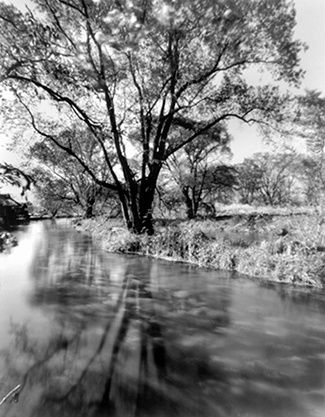 |
|
|
|
A slow one-minute exposure reveals the special effect of breeze-rustled leaves, and gives the patina of old polished pewter to the flow of water in River Guardian (1996).
|
The softly evocative images were taken over two decades in Japan, France, Germany, Hungary, Lithuania and the United States. But as the title suggests, and indeed Levinson's own life journey reveals, these long-exposure scenes of rivers and trees, meadows and mountains, sky and sea have less to do with discrete places and points in time than with the rhythms of light, water, earth and air that unite them. Whisper of the Land, both the photo exhibition and the collection of essays, is a meditation on hearing, seeing and feeling those elemental forces with the heart.
 |
|
One of the artist's best-known works, Forest Path (1994) leads the eye from a shrine into the mountains. Levinson says the pinhole camera's long exposures are sacred moments when he opens his mind and heart along with the shutter, becoming one with the surroundings. The late oud virtuoso Hamza El Din, a Sufi, saw the Arabic script for "Allah" written in this print's swirling interplay of light and trees. |
"Shapes and colors, smells and patterns are what attract me," Levinson writes. "Like an alchemist, I want to transform them and their essence into another kind of beauty, to give them eternal life through a photographic portrait." For many, that continuity registers as a personal feeling of nostalgia upon viewing his images. It's as though the potency of his distillations triggers mind travel not to the scenery mounted before us, but to inner landscapes we each carry within.
Levinson's creative nexus in the real world is Solo Hill, the home, studio, and sprawling garden he shares with Shizuka Tsuruta on the Boso Peninsula in Chiba, two hours and a world away from Tokyo. A well-known author herself, Tsuruta has published some 30 books on natural living; in the late seventies her writings were the first to introduce western concepts of vegetarianism to Japan. Mother Earth Kitchen (1990) was the couple's first joint publication; many collaborative works on food and the organic lifestyle have followed.
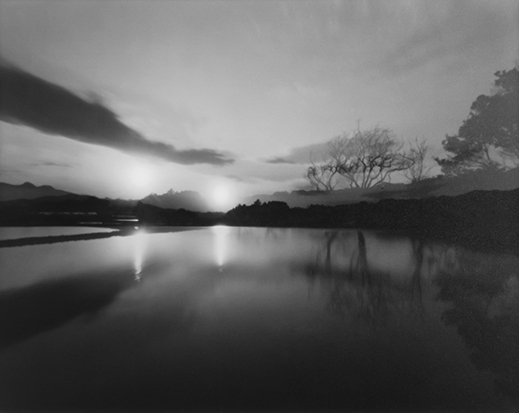 |
|
The hauntingly peaceful Spring Sunset (1995), taken not in a faraway galaxy but rather a few valleys from the artist's present home, is a double exposure -- thus the two suns and seemingly floating landscape. |
Levinson's Whisper of the Land essays recount the journey that brought Solo Hill into being. When he and Tsuruta purchased the half-acre mound of land in 2000, it was a tangled mass of fallen trees and creeping vines, serviced neither by road nor power and water lines. On its crest sat terraced rice paddies abandoned 20 years earlier. Yet there was plenty of wide-open sky, and they saw the possibilities. "We would nurture this neglected piece of land and it would nurture us back," Levinson writes of their on-the-spot decision. A work of metaphor that intersperses both journal entries from years past and his own haiku with more recent observations, his book tells of tilling soil and soul to unearth beauty and meaning. Like his photographs, it suggests that the seeds of inner experience, as well as those of the future, are always immediately before us, alive in the present.
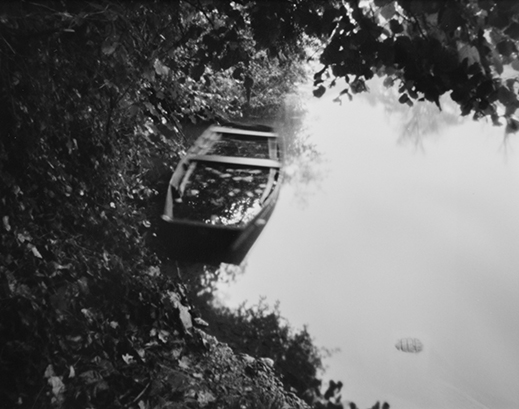 |
|
A new print, The Journey (2013) was taken in the French countryside near Besançon. "The restless spirit still needs to wander here and there in search of stimuli, looking for food. I am full, but still hungry; the soul needs feeding," writes Levinson of his muse. |
An American who hails from Virginia, Levinson began studying photography in his early twenties, in 1974. He gave it up for a decade, picking it up again after Japan had been his home for five years. But it wasn't until 1994, when life had sped up with an assault of publication projects and criteria-riddled photo assignments, that he settled into the pinhole technique as a return to something simpler. With no lens, no viewfinder, and just two or three shots per image, the results depend on intuition and chance. His rediscovery of this form of image-making not only rescued him from "the tyranny of too many lenses and rules," it brought the added bonus of boosting his photographic career. Levinson gave regular pinhole workshops and lectures for a decade and published a popular "why-to" book in Japanese; in Japan today his name is closely associated with the art. On the opening night of Whisper of the Land, the Ginza gallery was filled with aficionados of the method, fans and former students included.
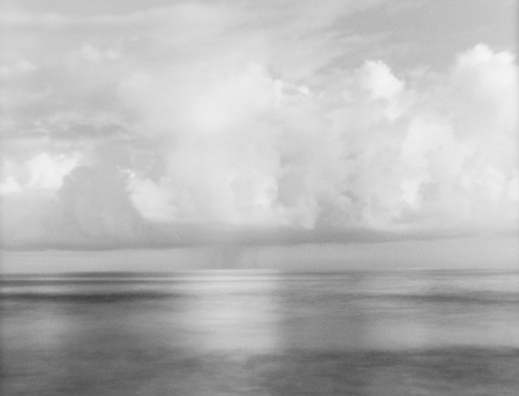 |
|
Always watching the light and chasing the shadows, Levinson says the ocean, especially at dusk, reminds him to keep a wide perspective on life. Floating #2 (2013) softens the sea's flow toward a horizon capped by billowing clouds. |
On the Boso Peninsula en route to interview Levinson at Solo Hill, my train ran through a tunnel of green. Hills rose sharply on the right; on the left, glimpses of the Pacific shimmered between leafy groves studded with late-blooming cherry trees. The ocean view opened as the cars rounded a bend. Sunday surfers bobbed in the water like seals, awaiting the next wave. On the rocks closer to shore, men and women carrying bamboo baskets foraged for hijiki seaweed. Later I would smell the smoke of wood fires stoked to dry-cure their harvest, which might turn up in my local market and then on my table. Tokyo seemed at once far away, and close. Glancing down at the open page of Whisper of the Land on my lap, I read: "The spirit of freedom is here to enjoy and spread, if I can stay away from the cage-like perceptions in the mind and attune to the oneness of life." The outing, like Levinson's works, carried the message that all around us everywhere there are fields to cultivate, symbols to harvest and share, and imagery to feed and sustain the soul.
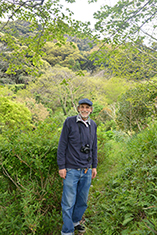 |
|
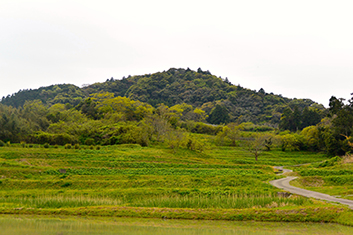 |
|
Edward Levinson at home on Solo Hill. In late spring, there are more shades of green here than can possibly be counted. Photographs by Susan Rogers Chikuba
Unless otherwise noted, photographs are by Edward Levinson. All images are published by permission of the artist and Art Gallery M84.
|
 |
 |
Susan Rogers Chikuba
Susan Rogers Chikuba, a Tokyo-based writer, editor and translator, has been following popular culture, architecture and design in Japan for three decades. She covers the countryfs travel, art, literary and culinary scenes for domestic and international publications. |
|
 |
|